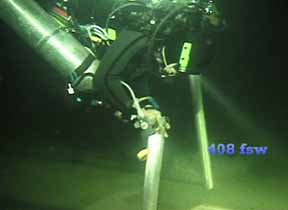
Taking the core samples

The core sample
The Blue Hole acts as a giant sediment trap. Any particles in the water will sink to the bottom, providing a record of marine and atmospheric environmental changes with time. In this picture a core sample is being retrieved from the deepest part of the bottom, at a depth of 123 msw (408 fsw).
Dr Eugene Shinn of the US Geological Survey writes:
We sliced one of the two cores and found it is well laminated and contains several distinct storm layers. We assume they are storm layers because the laminated muds are interrupted by 2 to 3 mm thick layers of reef sand which made it all the way to the center of the Blue Hole. A storm, either a strong winter front or a hurricane, is needed to do that.
We are in the process of doing lead 210 dating to determine the rate of sedimentation, and a palynologist (person who studies pollen) within the USGS has agreed to analyze the pollen and look for African species. In addition, a suite of samples are undergoing elemental analysis using ICP in a commercial lab in Denver. This analysis should tell us if African soil is present.
What makes the core so good is that because of the hydrogen sulphide and lack of oxygen there are no organisms burrowing up the sediment; thus, we have nice undisturbed layers.
For more information on iron-rich African dust and its effects on Caribbean ecosystems click here.

